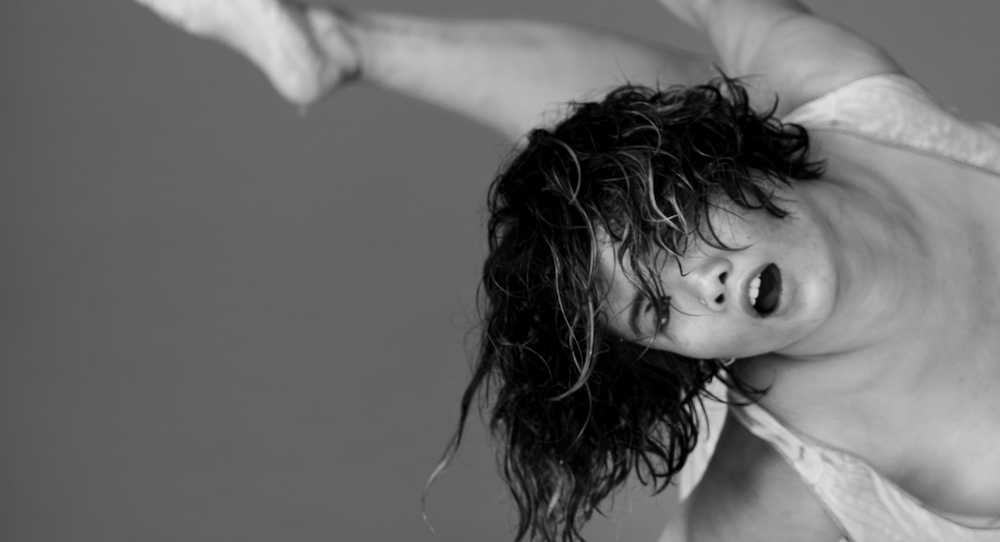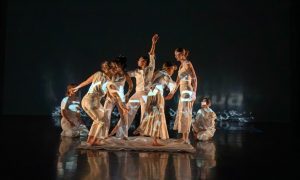It’s sometimes said that art can act as a mirror to life, to reflect the world back at us so that we can see it anew — or, sometimes, really see parts of it for the first time. The latter seems to be a key driving focus for Belinda Adam’s art. Adam is a New York City-based dance artist born, raised and first trained in dance in Indonesia.
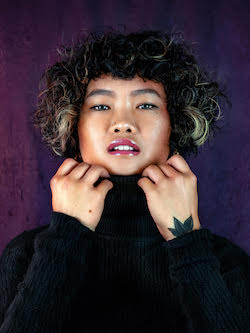
Belinda Adam. Photo by Andy Moreta.
Her work takes close, and sometimes hard, looks at the in-between, unseen and under-recognized in individual and collective human experience; she probes questions of identity, marginalization, the often messy and difficult process of healing, and more. Dance Informa spoke with Adam about this work, her journey in dance, her life as an NYC dance artist not yet naturalized in the U.S. and more. We hope that she gives you some fruitful food for thought.
Please share a bit about your background, and how you came to dance.
“I grew up in Medan, a city in the Northern province of Sumatra in Indonesia. It is a place where multi-ethnicity (Malay, Indian, Chinese and Batak) seems to happily co-exist among one another on the outside, yet pride and prejudice can still be vividly felt. Being in an environment with very limited resources in the arts, where the majority of people are too preoccupied with fulfilling the basic necessities of survival, I fell in love with movement.
My family put me in a dance class when I was three years old. It felt like dance and performance gave me a purpose. It was the only outlet that I am fortunate to have access to, a place where I feel I was given the room to fully, freely and honestly express myself, and most importantly to connect, intimately. Growing up in a very tiny community and in a conservative culture where questioning is labeled as bad and obedience is celebrated, dance offered me deep provoking thoughts and experiences. It gave me a secret space where I get to quietly rebel and have a conversation with myself about parts of myself I didn’t feel understood or accepted.
Dance and performance arts have always been a survival kit for me. It is my religion, my spiritual motivations. It is my mission as an artist, immigrant and activist, to convince people through my work that what we feel is a greater significance than what we see, or what we think others see. What we truly feel shall be the guiding force, to elevate ourselves and our communities.”
You said that you came to America to ‘find [your] otherness’. Can you expand on that a bit?
“Coming to America, I was able to paint and recreate my identity from a blank canvas, giving myself space from the cultural background and beliefs that were placed on my lineage I was supposed to carry. I did not come to just any part of America. I moved to Los Angeles, to pursue a better education in 2009, and to New York, to establish my career in the performance arts in 2015. These places are the melting pots of cultures and stories. I have built for myself a sense of home and belonging that I did not get growing up.
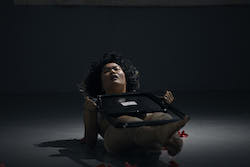
Belinda Adam. Photo by Jeremiah Cumberbatch.
Meeting, working and connecting with people from totally different upbringings have opened my perspective and humbled me in so many ways. It built in me a capacity for compassion toward myself and others that I wouldn’t be able to begin to comprehend before. I do not have to stand on black or white to feel like I belong. I get to be grey, exist in between. I do not have to fit in in order to feel I belong.
And this is my otherness, one that makes me feel whole — a community that celebrates my difference, who listens to my story with genuine intention to connect and a space that continuously pushes me to express myself to the fullest. Home for me cannot just be in my hometown, and it can’t just be in America. Home for me is the hunger, the movement, the change that I continuously seek for myself and strive toward in order to better understand my sole purpose of existence.”
What has been the most challenging part of working as a dance artist in NYC?
“I think the most challenging part of being an artist in general is finding resources and having the freedom to produce work at the scale that we want to, while simultaneously staying true to our belief system. There is lack of financial structure that can support artists’ continuous research, especially those in emerging and mid-career stages. It is very real and true that this deeply flawed system often leads to burnout, interpersonal trauma and twisted defense mechanisms. Like many fellow artists who share this experience, we develop an unhealthy relationship with work for the sake of sustaining ourselves.
For instance, there’s a lot of free labor — it’s the core system upon which the productivity in the dance world is built. Even if it isn’t at the top, it starts there, unless you have a trust fund or a relationship with somebody who is willing to invest their money in you. The financial structure just is not built to compensate that. If we take away free labor in the dance community, there would probably be barely anything left standing. This is a huge issue, as it trivializes the years of training and expertise a dancer has spent developing themselves; it is beyond insulting to pay dancers with ‘exposure’.”
You also said that you seek to make work that ‘demystifies the human’. What, more specifically, does that mean for you? Can you describe an example of how your work has done that?
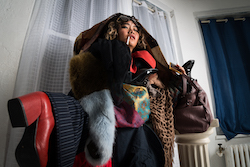
Belinda Adam. Photo by Aimee Lalonde Photography.
“This means that I seek to make work that invests my knowledge and resources into revealing the core of what makes us all intrinsically and deeply human — beyond the labels that society puts on us. For instance, I am an immigrant female artist; my partner, Talia Moreta, is a queer Afro-Latina artist; our collaborators are mostly artists whose identities lie in the grey area. We feel that our identities are placed in the margins because the world has not given us the tools to understand that we are just as human as everybody else. These labels come with a sense of inhibition that separate us from the privileged group.
At the end of the day, our works are meant to celebrate how unique we are as individuals and universal we are as a whole – that despite our labels, whether we are systematically more or less privileged, we all feel joy, pain, misunderstood and love. These feelings and sensations are what make us feel alive; it is what makes all of us human; and that is something that everyone can understand despite race, creed, appearance.
This is the inspiration that sparks Talia and I to create our own dance laboratory called Suku Dance Lab. Suku Dance Lab is a radically inclusive company – we are looking to not only be inclusive by the presence and aesthetic of our work on stage but also in the casting of others, and in the stories told. We are trying to bring to the forefront the voice and stories, especially of the marginalized groups, by creating a safe space for us to express and celebrate ourselves wholly, support one another, and tell ‘our own stories’. It is crucial that these stories are told through the raw experience of the subject involved and not through the filtered gentrified vessels.
For example, our most recent work is titled ANIMA. It is an immersive solo performance that showcases a woman who faces the challenges of femininity within the dominant patriarchal culture. Imageries in the work are meant to showcase the multitude of societal expectations placed on women, in relation to the performers inner trauma, childhood memories and her personal journey.
Choreographing, directing and performing this piece myself particularly, has allowed me to demystify the idea that healing is a beautiful thing. We tend to mask the idea of healing by hiding the reality that it is really hard, ugly, unpredictable and messy. And more importantly is that this messy process is okay. It is okay to have to go through the hard, ugly and unpredictability of healing.
That is the reason why Talia and I like to incorporate a piece of audience interactivity in our works, so they get to actively support and witness the evolution of the performer’s journey, and to be a real part of it. In doing this, the audience are not just a camera lens viewing the performer as an object; they are now in a relationship with the performer. By seeing outside themselves the most innately human and vulnerable part of someone else’s being unleashed, they can then understand and accept their own.”
In the NYC and American dance ecosystem, what do you feel that you uniquely contribute? What might you like to be able to further contribute, through growing and evolving as an artist and shifting your focus?
“I have been asked this question a lot, and I’ve thought about it a lot. I constantly feel like I am asked to prove how I can contribute uniquely not just in a work environment, but also through the legal system, since I am an immigrant, in order to be allowed my visa to stay and continue to develop work. It is important to remind myself that I am viewing my contributions through the lens that is true to my core value.
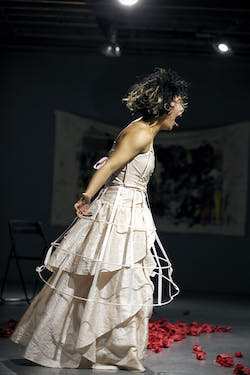
Belinda Adam. Photo by Jeremiah Cumberbatch.
I, as a person, contribute honesty, integrity, compassion and a strong belief that each person truly deserves the right to be successful as they are without having to augment, mold, shift into or pretend they are something they are not. I have a hard time witnessing people do that; it reminds me of a past reflection of myself pretending to be someone else for so long that I have a hard time accepting the concept of how we must alter ourselves to be accepted. I cut through superficial space in a loving and compassionate way — truly encouraging others to be themselves and to create from an honest place.
I also do that by holding that integrity for myself even when I am around others. When I am dancing and creating in my space, I am extremely honest – honest when I am excited, shy, awkward, certain, honest even when I am not being honest with myself. When somebody asks me something that does not resonate with me, I am pretty vocal about it verbally and physically. I maintain this not only as a director and creator but also as a dancer. I invest my skills in working with people who respect and allow me to hold my own integrity. Honesty and integrity are very important in this world of smoking mirrors.
That is what’s going to make the most change: standing strong in who you are and what you believe, especially when what you believe is outside of the typically upheld beliefs. That is who change-makers really are — the people who are persistent about their beliefs and demand the space to exercise them. I believe that I have that change-maker persona and ability. I am always making change, regardless the scale, within and outside of my being.
I am not as accommodating as I might think of myself to be. At my core, I stand strong in who I am, I know what I believe is right, I know what I deserve, and I want what I want. And what I want is justice and freedom. So that is how I contribute: by paving and making the space for justice and freedom through honesty, and persistently encouraging others to share the space with me.”
You can follow Belinda Adam and Suku Dance Lab on Instagram: @adambelinda and @suku_dance. To learn more about her work, visit www.sukudancelab.com.
By Kathryn Boland of Dance Informa.


